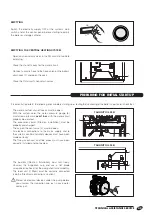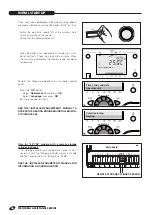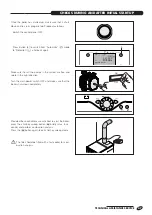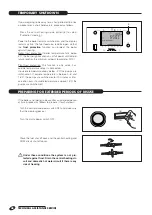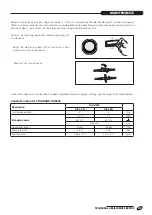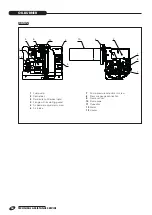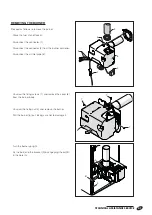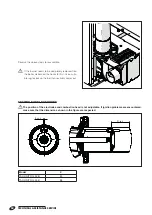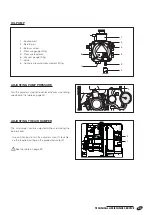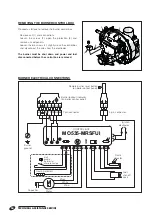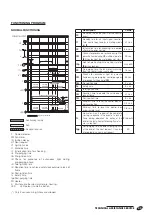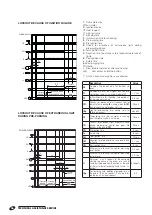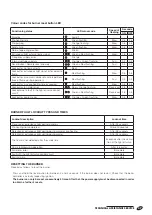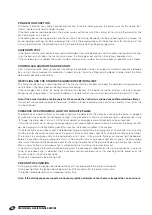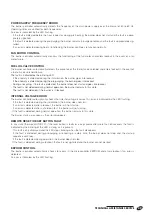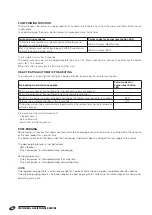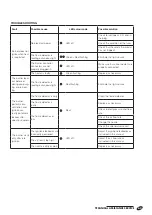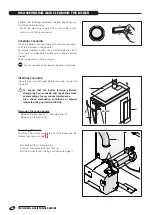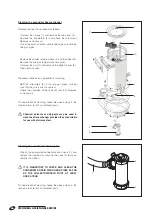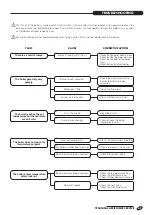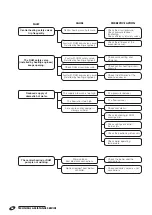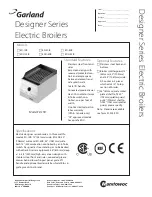
TECHNICAL ASSISTANCE SERVICE
58
PRE-HEATING FUNCTION
The burner controller has a fuel oil pre-heating function. In the pre-heating phase, the burner waits for the startup ther-
mostat, located at the nozzle holder, to close.
If the flame goes out during operation, the burner carries out the recycle if the contact of the start-up thermostat (or the
pre-heating one, K) is closed.
If the flame goes out during operation and the contact of the start-up thermostat (or the pre-heating one, K) is open, the
burner purging continues for the pre-purging time (if set), the purging stops and the burner waits for the contact of the
start-up thermostat (or the pre-heating one, K) to close before restarting the pre-purging time.
SHUTDOWN TEST
If the reset or remote reset button is pressed and held down for a time between 5 and 10 seconds during normal functio-
ning, the burner shuts down, the fuel oil valve closes, the flame goes out and then the startup sequence starts.
If the shutdown test is enabled, the current number and maximum number of startup sequence repetitions are zeroed.
CONTROLLED SHUTDOWN AND RESTART
After a maximum of 24 hours continuous functioning, the controller initiates an automatic shutdown sequence followed
by a re-start. You can reduce this automatic shutdown time to 1 hour (see "Programming Mode") in order to test the flame
detector for possible malfunctions.
RECYCLING AND THE STARTUP SEQUENCE REPETITION LIMIT
The burner controller has a recycling function. This means that the controller will repeat the complete startup sequence
up to 3 times if the flame goes out during normal functioning.
If the flame goes out 4 times, the burner controller enters lockout. If the burner controller receives a new heat request
during the recycling process, the total of 3 attempts is restored when the maximum temperature thermostat (TL) trips.
Note: If the burner functions continuously for 510 seconds, the controller is allowed one additional startup attempt .
Disconnect and reconnect power to the burner to obtain a further complete series of startup attempts (max. 3) for the
next heat request.
PRESENCE OF EXTRANEOUS LIGHT OR PARASITE FLAME
The presence of a parasite flame or extraneous light can be detected in the stand-by state when the burner is stopped
or waiting for a heat request or during pre-heating. If the presence of a flame or extraneous light is detected also in the
"t2" stage, the motor does not start until the flame signal has disappeared or until lockout has been reached.
If after the fan motor starts, during the pre-purging, an extraneous light or parasite flame is detected, the burner contin-
ues the purging until the light/flame goes off or reaches the lockout condition in 25 second.
If a parasite flame or extraneous light is detected during pre-purging, the pre-purging time of 15 seconds is reset to zero
and the time for checking the presence of the parasite flame or extraneous light starts (the motor continues to ventilate).
The function is cumulative and can be performed up to 2 times. If the parasite flame or extraneous light disappears
before 25 seconds, the pre-purging time starts; if the parasite flame or extraneous light occurs again, the pre-purging
time is reset to zero and the 25-second count for checking the presence of the parasite flame or extraneous light restarts.
When a parasite flame or extraneous light is detected for the third time, the burner locks out.
If, during missing flame recycling while operating and the consequent repetition of the start-up sequence, a parasite
flame or extraneous light is detected, the 25 seconds control countdown starts (for checking for the presence of the
parasite flame or the extraneous light).
The fault is indicated by the blinking LED.
PRE AND POST-IGNITION
During pre-ignition, the ignition electrode switches on 2 seconds before the fuel oil valve opens.
During post-ignition, the ignition electrode switches off 3 seconds after the end of safety time.
The ignition electrode remains on throughout safety time.
Note: If the startup sequence repeats continuously, ignition attempts cannot be more frequent than one a minute .


